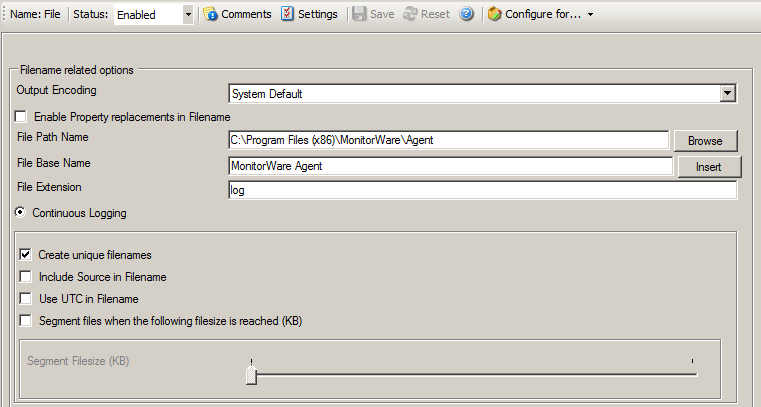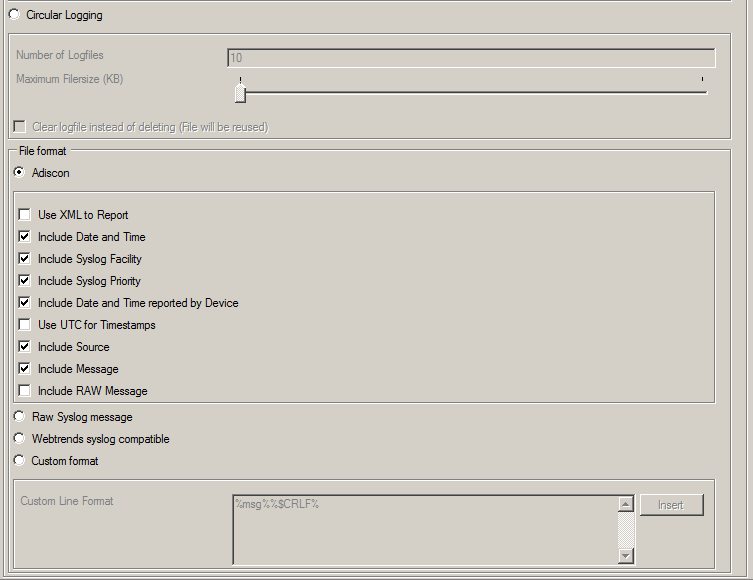This configuration dialog is available both in the defaults section as well as with file logging actions.
File logging is used to write text files of received messages. One file per day is written. New entries are appended to the end of the file.
File locks are released when currently no data is written. Therefore, other applications can access the files while the service is running. However, please be sure that the other applications do not place a file-lock onto it. Popular WordPad does so. In this case, the service will not be able to log any further messages (an error event is written to the NT Event Log in this case). We recommend copying the file when accessing it at runtime - or use notepad.exe, which does not place file-locks on the files it opens.
The filename is build as follows:
<FilePathName><FileBaseName>-year-month-day.<FileExtension>
Parameters in the brackets can be configured via dialog shown below:

File Logging Options
Enable Property replacements in Filename
By activating this option, you can use properties within the file or pathname like %Source% and all the others. For example:
File Path Name can be F:\syslogs\%source%
File Base Name can be IIS-%source%
If your source is 10.0.0.1, that writes the following file:
F:\syslogs\10.0.0.1\IIS-10.0.0.1.log
Please note that the path f:\syslogs\10.0.0.1 was generated because the source poperty was used inside the path.
Note: You can use ANY property inside the path and base name. Event properties are described in the property replacer section.
The base path (directory) of the file. Please see above for exact placement. Default is "c:\temp". The Insert Menu entry allows you to create "Dynamic Directories". For example:
File Path Name can be F:\syslogs\%source%
Event properties are described in the property replacer section.
The base name of the file. Please see above for exact placement. Default is "MonitorWare". The Insert Menu entry allows you to recreate "Dynamic Base Filenames". For example:
File Base Name can be IIS-%source%
The extension to be used when writing the file. Please see above for exact placement. Default is ".log".
If checked, MonitorWare Agent 3.0 creates a unique file name for each day. This is done by adding the current date to the base name (as can be seen above).
If left unchecked, the date is not added and as such, there is a single file with consistent file name. Some customers that have custom scripts to look at the file name use this.
If checked, the file name generation explained above is modified. The source of the Syslog message is automatically added to the file name.
This feature has been introduced because many customers would like to have separate log files for each device. While this can be achieved with multiple rules, it is much more straight forward with this single checkbox. If it is checked, the messages are automatically written to separate files and the file name includes the originating device information.
This works together with the "Create unique Filenames" setting. If unique names are to be created then select the "Use UTC in Filename" option, in this case the file name is generated on the basis of universal co-ordinated time (UTC) or on local time. UTC was formerly referred to as "GMT" and is the basis of the time zone system. For example, New York, USA is 5 hours behind UTC. Therefore, if it is 12 noon in New York, the UTC time is 5pm.
When it comes to log file creation, it means that the date is computed on UTC. Taking the same example, if the "Use UTC in Filename" is checked, the log file name would roll over to the next date at 7 pm New York time. If it were unchecked, the rollover would occur exactly at midnight New York time (5 am UTC).
Using UTC for file name creation can be helpful if log files are written among different time zones and later consolidated. Using UTC ensures a consistent time notation across all log files.
Please note that this setting does affect the file name creation only. A different setting controls the dates recorded inside the file.
Segment files when the following file size is reached (KB)
Files are seqmented when the defined file size is reached. The file name will have a sequence number appended (_1 to _n).
Event properties are described in the property replacer section.

File Logging Options #2
Use Circular Logging
When enabled log files are created and over written in a cycle.
Number of Log files
Once the last logfile is reached, circular logging begins and over write the first log file again.
Maximum File size
Max filesize of a log file, once this size is reached a new logfile is created.
Clear logfile instead of deleting (File will be reused)
This option causes the File Action to truncate the logfile instead of deleting and recreating it.
This controls the format that the log file is written in. The default is "Adiscon", which offers most options. Other formats are available to increase log file compatibility to third party applications.
The "Raw Syslog message" format writes raw Syslog format to the log file. That is, each line contains the Syslog message as of RFC 3164. No specific field processing or information adding is done. Some third party applications require that format.
The "WebTrends Syslog compatible" mimics the format that WebTrends applications expect. Please note that we only mimic the log file format. It is still the job of the reporting device (most notable firewall) to generate the correct WebTrends WELF format. The "WebTrends" format is supported because many customers would like to use MonitorWare Agent 3.0 enhanced features while still having the ability to work with WebTrends.
The "Custom" format allows you to customize formats to increase log file compatibility for third party applications. When you choose this option then Custom line format is enabled.
Please note that any other format besides "Adiscon Default" is a fixed format. As such, if it is selected, all other formatting options do not apply and consequently are turned off.
General file options
Under this group box, you can see two options discussed as under:
If checked, the message part includes a complete XML-formatted information record. It includes additional information like timestamps, Syslog facility and priority and others in an easy to parse format. If XML output format is selected, you might consider turning all other information fields off, as they are already included in the XML stream. However, this is not a requirement.
Please see the definition of UTC above at "Use UTC in Filename". This setting is very similar. If checked, all time stamps are written in UTC. If unchecked, local time is used instead. Again, UTC is useful if logs written in multiple time zones are to be consolidated.
The various "include" settings controls at the bottom are used to specify the fields which are to be written to the log file. All fields except the message part itself are optional. If a field is checked, it is written to the log file. If unchecked, it will not be written. All fields are comma-delimited.
Please note the difference between the "Date and Time" and "Date and Time reported by Device". Both are timestamps. Either both are written in local time or UTC based on the "Use UTC for Timestamps" check box. However, "Date and Time" is the time when MonitorWare Agent 3.0 received the message. Therefore, it is always a consistent value.
In contrast, the "Date and Time Reported by Device" is a timestamp taken from the actual message. As such, it is dependent on the reporting device clock, which might be off. In addition, in the case of Syslog messages, there is no time zone information within the device reported timestamp. As such, if devices from multiple time zones are reporting, the timestamp information is not consistent. This is due to Syslog design as of RFC 3164. The Syslog server can be configured to ignore the RFC in this case and provide a consistent time stamp. However, from the view of the log file writer, the "Date and Time Reported by Device" might not be as trustworthy as the "Date and Time" field. Nevertheless, it might also be more useful than the former one. This is the reason both timestamps are present and can individually be selected.
The "Include Message" and "Include RAW Message" fields allow customizing the message part that is being written. The raw message is the message as MonitorWare Agent 3.0 – totally unmodified, received it. This might be useful if a third party application is expecting raw Syslog entries. The message itself is just that part of the Syslog message that is being parsed as message that is without e.g. host information or a tag value. Please note that we recommend selecting only one of these options, as otherwise two message fields are written. Similarly, if none is selected no message is written at all. Please note that we support these configurations, too – there might be a legitimate need for them.
Custom Line Format
Custime Line Format enables you to fully customize the output for the log file. The Insert Menu entry provides further options and they only work in custom line format. Default value is "%msg%%$CRLF%".
Configure For ...
If you want to generate the reports on log files using Monilog or MonitorWare Console, then its absolutely necessary that the log files are in a specific format. This option allows you to configure the file logging format for Monilog and MonitorWare Console.
If the log file entries are not in the correct format for MonitorWare Console (for PIX or Windows Reports), then it writes error messages for first 50 lines in Windows event log and ignores them for the generation of report, resulting in a generation of empty report.
And, if the log file entries are not in the correct format for Monilog, then an empty report woud be generated.
Following three options are available:
| 1. | Configure for MonitorWare Console PIX Reports |
| 2. | Configure for MonitorWare Console Windows Reports |
| 3. | Configure for Monilog |
Configure for MonitorWare Console PIX Reports
This option changes the file logging format of MonitorWare Agent to the correct format expected by MonitorWare Console for PIX report generation.
Configure for MonitorWare Console Windows Reports
This option changes the file logging format of MonitorWare Agent to the correct fromat expected by MonitorWare Console for Windows report generation.
Configure for Monilog
This option changes the File Logging format of MonitorWare Agent (i.e. custom line format) to the correct format that is expected by Monilog for report generation.